
Carex flacca, with common names blue sedge, gray carex, glaucous sedge, or carnation-grass,, is a species of sedge native to parts of Europe and North Africa. It is frequent in a range of habitats, including grasslands, moorlands, exposed and disturbed soil, and the upper edges of salt marshes. It has naturalized in eastern North America.
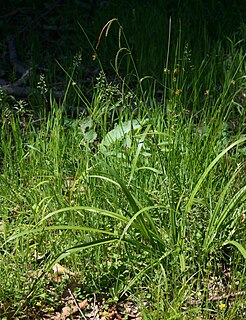
Carex pendula is a large sedge of the genus Carex. It occurs in woodland, scrubland, hedges and beside streams, preferring damp, heavy clay soils. It is sometimes grown as a garden plant because of its distinctive appearance.

Carex comosa is a species of sedge known as longhair sedge and bristly sedge. It is native to North America, where it grows in western and eastern regions of Canada and the United States, and parts of Mexico. It grows in wet places, including meadows and many types of wetlands. Tolerates deeper water than most common species and is good for retention basins. This sedge produces clumps of triangular stems up to 100 or 120 centimeters tall from short rhizomes. The inflorescence is up to 35 centimeters long and has a long bract which is longer than the spikes. It is a cluster of several cylindrical spikes. The scales over the fruits taper into long, thin awns.

Carex lenticularis is a species of sedge known by the common names lakeshore sedge and goosegrass sedge. It is native to much of northern North America, including most all of Canada and the western United States, where it grows in wet habitats.

Carex rossii, commonly known as Ross's sedge, is a hardy species of sedge that is often a pioneer species in areas with little or no established vegetation, or in places where disturbance has occurred. Ross's sedge grows in a variety of habitats throughout much of western North America, from Alaska to Ontario, south to New Mexico and California. It flowers in May and June.

Carex hirta, the hairy sedge or hammer sedge, is a species of sedge native across Europe. It has characteristic hairy leaves and inflorescences, and is the type species of the genus Carex.

Carex bigelowii is a species of sedge known by the common names Bigelow's sedge, Gwanmo sedge, and stiff sedge. It has an Arctic–alpine distribution in Eurasia and North America, and grows up to 50 centimetres (20 in) tall in a variety of habitats.
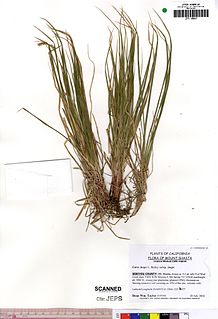
Carex inops is a species of sedge known as long-stolon sedge and western oak sedge. It is native to northern North America, where it occurs throughout the southern half of Canada and the western and central United States.

Carex brunnescens, the brownish sedge or green bog sedge, is a species of plant in the sedge family (Cyperaceae). It has a circumboreal distribution, and is native to North America and Eurasia. In the United States it is primarily found in the Northeast and Midwest extending south into the Appalachian Mountains, with disjunct populations westward in the Rocky Mountains. It has a wide-ranging natural habitat, is in found in forests, bogs, fens, and rock outcrops.
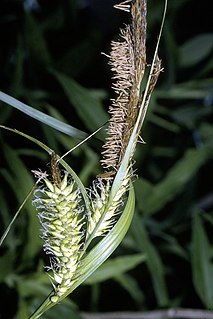
Carex lacustris, known as lake sedge, is a tufted grass-like perennial of the sedge family (Cyperaceae), native to southern Canada and the northern United States. C. lacustris us an herbaceous surface-piercing plant that grows in water up to 50 cm (1.6 ft) deep, and grows 50–150 cm (1.6–4.9 ft) tall. It grows well in marshes and swampy woods of the boreal forest, along river and lake shores, in ditches, marshes, swamps, and other wetland habitat. It grows on muck, sedge peat, wet sand or silt, in filtered or full sunlight.
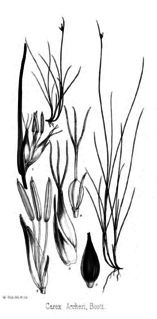
Carex archeri, known as Archer's sedge, is a species of sedge in the genus Carex, endemic to south-eastern Australia.
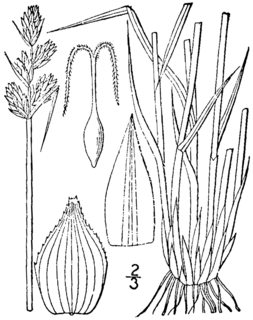
Carex adusta, commonly known as the lesser brown sedge or the browned sedge, is a species of sedge (Carex) in the section Ovales. First described scientifically in 1839 by Francis Boott, it is found in Canada and the northeastern United States, where it grows in dry, acidic, sandy soils. Adusta is Latin for "burnt," probably referring to the color.
Carex assiniboinensis, commonly known as the assiniboia sedge, is a species of sedge (Carex) in the section Hymenochlaenae. First described scientifically in 1884 by American botanist William Boott, it is found in Canada and the United States, where it grows in floodplain forests, old river channels, riparian woodlands, and shrub thickets.

Carex arctata, known as drooping woodland sedge, is a species of sedge native to eastern North America. It is sometimes called black sedge, compressed sedge, or drooping wood sedge. It occurs from Manitoba to the eastern seaboard in Canada, south to northwestern North Carolina, and west to Minnesota. Carex arctata grows in bogs, hardwood forests, and spruce forests.

Carex capillacea, common name yellowleaf sedge in Tasmania, is a species of sedge found in Assam, the far east of Russia, New Guinea, south east Australia, New Zealand, Malesia, China, Japan and India.
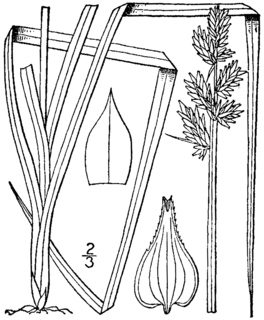
Carex conjuncta, known as soft fox sedge, is a species of sedge that was first formally named by Francis Boott in 1862. It is endemic to the central and eastern United States.

Carex rosea, the rosy sedge, is a flowering plant and part of the family Cyperaceae. Synonyms for Carex rosea include Carex concoluta, and Carex flaccidula. It is native to central and eastern North America and it exists in wet to dry soils. Carex rosea can be found in shores of streams and bottomlands, as well as ponds. It is known to have great adaptations to dry-shade locations. This is an evergreen, easy-to-grow-plant.

Carex bicolor, the bicoloured sedge, is a species of sedge native to North America, Northern Europe and Northern Asia. The International Union for Conservation of Nature has assessed the plant's conservation status as being of least concern because it has a widespread distribution and faces no particular threats.

Carex muehlenbergii is a species of flowering plant, it is a type of sedge. It is a grass-like plant in the family Cyperaceae. Its common names include sand sedge, Muhlenberg's sedge.


















